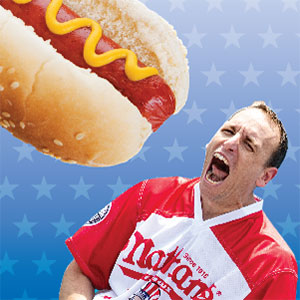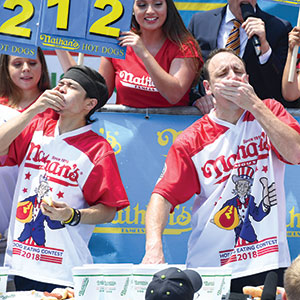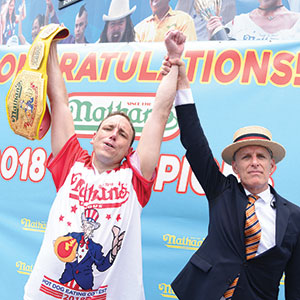

Lucas Jackson can’t hold a candle to Matt Stonie. The wiley and incorrigible character of “Cool Hand Luke”played by Paul Newman in the 1967 film of the same nameengaged in plenty of memorable and high stakes hijinx while doing time on a muggy Florida work farm. There were his numerous inventive escapes, his stubborn resolve in facing down George Kennedy’s hulking “Dragline,” and, of course, his successful attempt at eating 50 eggs.
“He’s an amateur,” Stonie says. “Times have changed. Move over.”
Stonie is only half kidding. It’s true that Luke’s 50-eggs-in-an-hour challenge was a work of fiction. It’s also true that Stonie stuffed 120 eggs down his gullet in just eight minutes on Oct. 5, 2013.
The San Jose native is a professional competitive eater. He’s ranked 3rd in the world by an organization known as Major League Eating. And, as stunning as his gut-busting feat may seem, it still falls short of the world record. At 141 eggs in eight minutes, that title belongs to another San Jose denizen known as Joey “Jaws” Chestnut.
Though the men are friendly with one another outside of competition, both have spent the past few months steeling themselves in preparation for the year’s biggest competition of consumption: the Nathan’s Famous Hot Dog Eating Contest.
This 4th of July, the two will face off yet againas Chestnut seeks to defend and perhaps best his world record of 74 hot dogs in 10 minutes, while Stonie endeavors to upset the reigning champ, as he has done just once before, in 2015.
EATING WELL
On Jul. 1, Chestnut is at the home he owns in the Blossom Hill neighborhood of San Jose. He didn’t pay cashcompetitive eaters don’t make that kind of money. But he did qualify for a mortgage based upon the income he generates by stretching his stomach.
“I can’t believe I’ve been doing it this long,” Chestnut says with a chuckle. When this all took off about 14 years ago, the Vallejo-born San Jose State University grad assumed he would eventually fall back on his civil engineering degree. Instead, what began with a first-place trophy in a Stockton asparagus eating contest, led to an impressive third-place finish at the 2005 Nathan’s Famous contest, and ultimately morphed into a career, complete with corporate sponsorships and his own line of mustard.
During his time in competitive eating, Chestnut has seen some pretty big changes. For starters, when he first took the stage in Coney Island, most of his challengersaside from the former world champ, Takeru Kobayashiwere overweight and out of shape.
“It was all trial and error,” Chestnut says of those early days in the mid-aughts. In the years since, Chestnut has honed his training regimen. His workouts include a number of exercises he has inventedlike chomping on stress balls, lifting weights attached to an athletic mouth guard and swallowing as much air as his stomach will allow while doing crunches.


All of this and more was recently captured by an ESPN film crew for the recently aired documentary, The Good, The Bad, The Hungry. The film, part of the sporting network’s 30 for 30 docuseries, debuted on Jul. 2. It follows the rise and fall of Kobayashithe Japanese competitive eating pioneer who played a significant part in turning Americans on to the sportand the ascent of Chestnut. For the better part of a decade, the rivalry between the two helped drive public interest in competitive eating.
Kobayashi was already well established in Japanwhere competitive eating took off years before it ever gained traction in the United Stateswhen he showed up at the 2001 Nathan’s Famous contest. That year he doubled the standing record of 25, downing 50 hotdogs in 12 minutes.
Kobayashi’s technique is broken down in great detail in The Good, The Bad, The Hungry. “Both speed and stomach capacity are necessary,” he explains while demonstrating his methods. First, he breaks two hot dogs in half, pushing all four pieces into his mouth and quickly swallowing; then comes the bun, which he dunks in water (the warmer the better), before sucking down the mush. No movement is wasted in the process. It’s all a seamless blura yogic flow of mastication and ingestion.
AMERICAN VALUES
Held annually on the 4th of July, the Nathan’s Famous competition is something of an American tradition. And like any good national pastime, it has spawned its own legends and lore.
It can be verified that the event dates back to 1972. But Mortimer Matz and Max Rosey, who began promoting the Nathan’s Famous event in the early ’70s, previously claimed that the challenge was first held on Jul. 4, 1916.
Matz, a somewhat notorious New York publicity agent, has since admitted that he and the late Rosey cooked up the stuntinventing the 1916 date “in Coney Island pitchman style” to give the event an aura of old-timey American authenticity. It worked. In a 2010 New York Times article, an editor’s note concedes that The Gray Lady was initially duped by the fabrication.
However, the truth in this instance is less important than the legend, according to George Sheawho began emceeing the Nathan’s Famous event in 1988 while working for Matz and Rosey. He would eventually break away from the established agency to form Shea Communications with his brother, Richard. In the ensuing years, Shea helped lead the Nathan’s Famous contest out of the obscure and uniquely New York subculture of Coney Island sideshows, transforming it into the World Cup of competitive eating.
The secret, he says, is storytelling. From Babe Ruth’s called shot, to Doc Ellis’ purportedly LSD-fueled no no, tall tales only grow taller as time passes and fans debate the facts. After enough time passes, a tall tale will become a myth.
Shea, who co-founded of the Major League Eating organization with his brother in 1997, is the mythmaker of competitive eating. The Good, The Bad, The Hungry makes that abundantly clear. Shea looms large throughout the documentaryboth in direct interviews and file footage.
BOARDWALK EMPIRE
“They say that competitive eating is the battleground upon which God and Lucifer wage war for men’s souls, my friends. And they are right,” Shea intones, pointing a trembling finger at the crowd. “For this is a battle for the ages. This is a battle for the titansthe early godswho come to Earth only once, in only one location. And that is at the corner of Surf and Stillwell avenues, at Nathan’s Famous.”
The monologue, which opens The Good, The Bad, The Hungry, rolls off Shea’s tongue. He has adopted the cadence of a carnival barker and wears a woven boater hat for aesthetic reinforcement. It is pure spectacleand that’s the point.
“Every single thing in our existence is about narrative,” Shea says over the phone, just one day before the airing of the documentary. “I really enjoy developing the introductions that I deliver. They’re very important to me. Some are comedic, some are epic, some are fantastical and just out-there.”


After the film’s opening sequence, viewers are introduced to the world of competitive eating at the turn of the millennium. While pie eating contests are common at county fairs and the Nathan’s Famous competition is known to New Yorkers, the majority of Americans have yet to catch on. But that is all about to change.
In 2001, Shea endeavors to increase the visibility of the Nathan’s Famous contest. He piques the interest of Josh Getlin, a journalist working at The Los Angeles Times, by telling him that there is a small circuit of contests for passionate competitive eaters.
“They are travelling the blue highways of America searching for glory,” Shea says, remembering his pitch to Getlin. Looking back, Shea admits that he may have taken a page out of Matz and Rosey’s playbook, but he doesn’t seem to regret it. The resulting piece, “To The Glutton, The Gold,” helped spur a wave of national media interest in competitive eating.
“A lot of what I say is not literally true,” he says in the 30 for 30 documentaryusing both his pearly white teeth and steely blue eyes to flash a knowing smile at his interviewer. “But it’s emotionally true.”
FEEDING FRENZY
The timing was perfect. Just as the national media began amplifying Shea’s narrative, Kobayashi arrived in America. He became a star of the then-fledgling genre of reality TV. One program from 2002, dubbed Glutton Bowl: The World’s Greatest Eating Competition, features Kobayashi downing nearly 18 pounds of cow brains in 15 minutes.
Chestnut was 20 years old when Glutton Bowl aired, and in The Good, The Bad, The Hungry, he reveals that Kobayashi was instrumental in inspiring him to pursue competitive eating.
In 2003, ESPN started broadcasting the Nathan’s Famous contest. A study of Google Trends shows that searches for “competitive eating” surged in the middle of the decadewith July 2007, the year Chestnut first beat Kobayashi in Coney Island, representing the greatest spike in queries.
The next year, 2008, saw the debut of the Travel Channel’s Man vs. Food program. Chestnut was featured in the 15th episode of the premier season. In that installment, host Adam Richman visited San Josehighlighting a hot wing challenge at Smoke Eaters, massive steaks at Henry’s World Famous Hi-Life and the Burritozilla at Iguanas.
With the exception of one tiewith Kobayashi in 2008and his loss to Stonie in 2015, Chestnut has taken the top spot in every Nathan’s Famous Hot Dog Eating Contest since 2007. He continues to push himself, with the aim of topping his personal best of 74 hot dogs.
However, as Chestnut grows older, he has begun to encounter new obstacles. He used to be able to perform a full training sessioneating as much as he can stomach as fast as possibleevery four days. Now he says his recovery takes nearly a week. He runs and hikes often to keep his cardiovascular system healthy. He says breath control is essential to his success as a competitor.
His metabolism is changing as well. Keeping his weight down is a constant concernboth for him and for his doctor, who reluctantly gives Chestnut a pass while encouraging him to be careful.
“She isn’t saying what I’m doing is healthy,” Chestnut says of his physician. “But she says it doesn’t seem to be hurting my body.”
Still, he adds, during the summerthe peak of the competitive eating seasonhe can expect to gain about 30 pounds. When winter rolls around, he works on cutting back. He eats less, works out more and catches up on projects around the house.
But just because he is dialing back the calories doesn’t mean he isn’t training. By pounding a gallon of water every morning he can keep his stomach in shape without gaining weight.
THE NEW SCHOOL
Sporting dynasties can be thrilling for fans of the winning team, but when contests become predictable they tend to lose their appeal. While Chestnut’s rise was a boon for Major League Eating, his continued dominance could eventually cause viewers to change the channel.
However, if followers of Major League Eating get their fill of Chestnut, they can always tune into Stonie.
An avid YouTuber, the 27-year-old Stonie has demonstrated what professional eating looks like in the social media age. In a recent video uploaded to his YouTube channel, Stonie plows through just about every item on the Chick-fil-A menu, cramming his thin frame full of chicken tenders, sandwiches, side dishes and drinks. It has more than 8 million views. Another video of Stonie eating 100 string cheese sticks has 4 million views and is sponsored by Dollar Shave Club.
Stonie has been uploading clips to the video sharing service for six years, and over the last year and a half he has seen a massive increase in viewership.
He boasts more than 8 million subscribers on YouTube, over 223,000 followers on Instagram and 57,000 followers on Twitter. His social media numbers far exceed Chestnut’s and the official channels of Major League Eating. “It’s my secret sauce,” he says.
While Stonie certainly benefits from the national stage that Major League Eating provides, it seems that Shea and his team are having trouble capitalizing on the power of social media.
“My clients have always asked for major, traditional media placement,” Shea says. “And we’ve always provided that.”
He knows how to land a spot on the Today show and can obtain prime placement in print tabloids. However, Shea admits he “didn’t truly understand the power” of platforms like YouTube until recently.
“Matt has an extraordinary presence,” Shea says. “I just like watching the guy.” But until Shea can figure out how to tap into Stonie’s secret sauce, all he will be able to do is watch from the sidelines.


